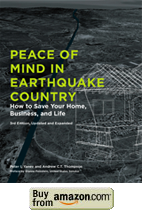Book References
Living with Earthquakes in California: A Survivors Guide; Robert S.Yeats; Oregon State University Press, 2001
California Earthquakes, Science, Risk, and the Science of Hazard Mitigation; Carl-Henry Geschwind; The John Hopkins University Press, 2001
Extreme Event Mitigation in Buildings, Analysis and Design; Brian J. Meacham, Matthew A. Johann, eds; National Fire Protection Association, Inc., 2006
Catastrophe Modeling: A New Approach to Managing Risk; Patricia Grossi, Howard Kunreuther, eds; Springer Science and Business Media, Inc. 2005
Catastrophic Risk: Analysis and Management; Erik Banks; John Wiley @ sons, Ltd.; 2005
Bracing for Disaster: Earthquake-Resistant Architecture and Engineering in San Francisco, 1838-1933; Stephen Tobriner; Heyday Books; 2006
Scenario for a Magnitude 6.7 on the Seattle Fault; Mark Stewart, ed; Earthquake Engineering Research Institute and the Washington Military Department Emergency Management Division; 2005
Scenario for a Magnitude 7.0 Earthquake on the Hayward Fault; Frances M. Christie, ed; Earthquake Engineering Research Institute; 1996
Financial Management of Earthquake Risk; Earthquake Engineering Research Institute; 2000
Integrated Risk Management; techniques and Strategies for Reducing Risk; Neil A.Doherty; McGraw Hill; 2000
Practical Lessons from the Loma Prieta Earthquake; National Research Council; 1994
EQE International; The January 17, 1995 Kobe Earthquake: An EQE Summary Report; April 1995
EQE International; Earthquakes of the 1980s; 1990
Earthquake Engineering Research Institute; The San Simeon, California, Earthquake December 22, 2003; 2005
Wood, H.O., and Neumann, F., 1931. “Modified Mercalli Intensity Scale of 1931,” Seismological Society of America Bulletin, Vol. 21, No.4
FEMA, 2004. Design Guide for Improving School Safety in Earthquakes, Floods, and High Winds, Publication 424, Federal Emergency Management Agency, Washington, DC.
ASCE, 2006. Minimum Design Loads for Buildings and Other Structures, ASCE/SEI 7-05, American Society of Civil Engineers, Reston, VA.
ASCE, 2003. Seismic Evaluation of Existing Buildings, ASCE/SEI 31-03, American Society of Civil Engineers, Reston, VA.
FEMA, 2000. Prestandard and Commentary for the Seismic Rehabilitation of Buildings, FEMA 356; Federal Emergency Management Agency, Washington, DC.
Earthquake Engineering Research Institute (EERI); Earthquake Spectra: 1999 Chi-Chi, Taiwan, Earthquake Reconnaissance Report; April 2001
Earthquake Engineering Research Institute (EERI); Earthquake Spectra: 1999 Kocaeli, Turkey, Earthquake Reconnaissance Report; December 2000
Earthquake Engineering Research Institute (EERI); Earthquake Spectra: 2001 Bhuj, India Earthquake Reconnaissance Report; July 2002
Reflections on the Loma Preita Earthquake, October 17, 1989; Structural Engineers Association of California; April 1, 1991
Earthquake Engineering Research Institute (EERI); Earthquake Spectra: Loma Prieta Earthquake Reconnaissance Report; December 2000
2007 Working Group on California Earthquake Probabilities; The Uniform California Earthquake Rupture Forecast, Version 2 (UCERF 2); U.S. Department of the Interior, the U.S. Geological Survey California Department of Conservation, and the California Geological Survey; 2008
NOAA Center for Tsunami Research; http://nctr.pmel.noaa.gov/
National Earthquake Hazards Reduction Program http://www.fema.gov/plan/prevent/earthquake/nehrp.shtm
Local Government Committee Tsunami Fact Sheet; EERI Northern California Chapter; 2005.
Putting Down Roots in Earthquake Country – Southern California; Southern California Earthquake Center (SCEC); 2007
Putting Down Roots in Earthquake Country – San Francisco Bay Region; U.S. Department of the Interior, U.S. Geological Survey; 2007
Seismic Hazard and Risk Analysis, Robin K. McQuire; Earthquake Engineering Research Institute (EERI); 2004.
FEMA, 2006. Homebuilders' Guide to Earthquake-Resistant Design and Construction, Publication 232, Federal Emergency Management Agency, Washington, DC.
